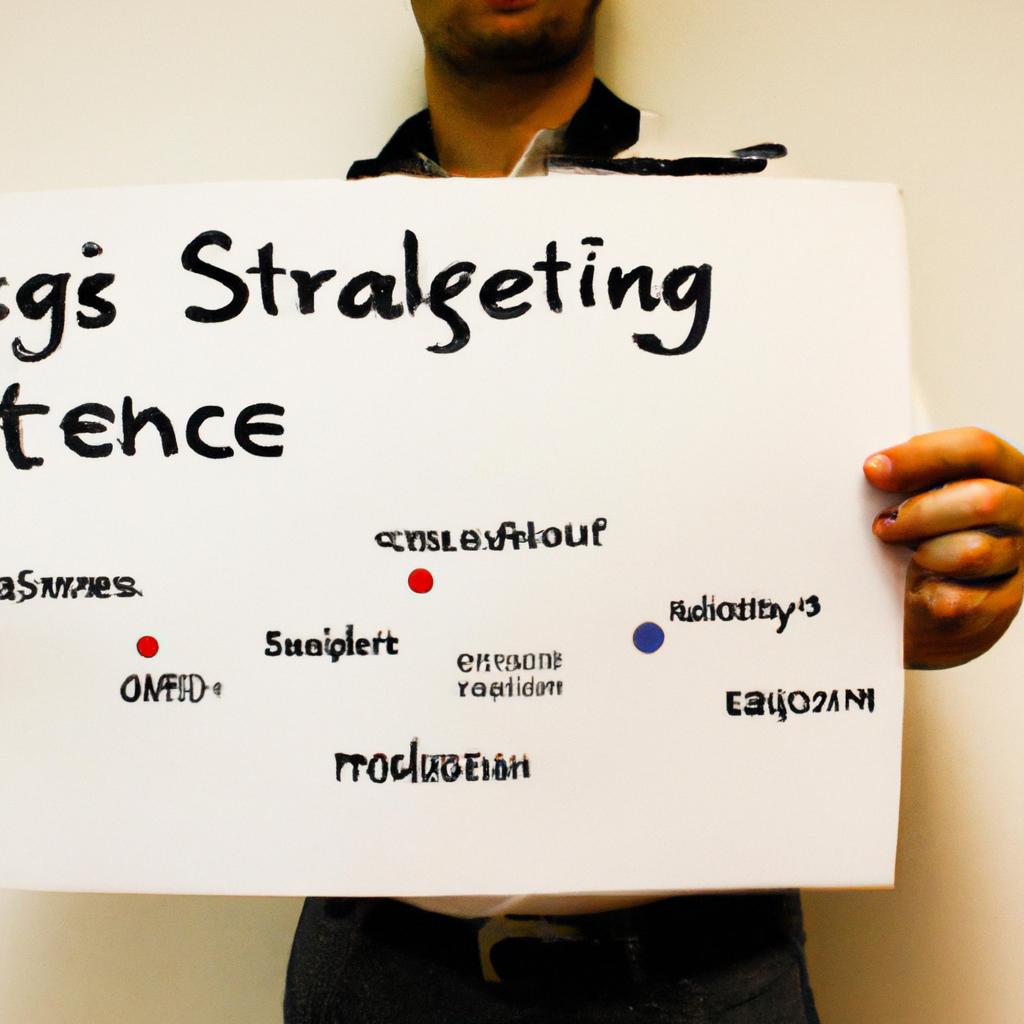Qualitative research methods play a crucial role in marketing and advertising market research, providing valuable insights into consumer behavior, preferences, and motivations. By understanding the qualitative aspects of consumer decision-making processes, marketers can effectively tailor their strategies to meet customer needs and achieve competitive advantage. This article explores the significance of qualitative research methods in the context of marketing and advertising market research.
For instance, consider a hypothetical scenario where a clothing retailer aims to launch a new line of sustainable fashion products targeting environmentally conscious consumers. In order to gain deeper insights into this specific target audience’s values, attitudes, and purchasing behaviors, qualitative research methods such as focus groups or in-depth interviews could be employed. Through these methods, researchers can engage with potential customers on an individual level or within small group settings to uncover underlying motivations for choosing sustainably produced clothing items over conventional ones. Such findings would provide invaluable guidance to the retailer when developing effective marketing campaigns that resonate with their target audience’s desires for eco-friendly options.
In summary, qualitative research methods offer unique advantages in the field of marketing and advertising market research by delving into the subjective experiences and perspectives of consumers. Understanding why individuals make certain choices allows marketers to develop strategies that cater directly to their target audiences’ needs and aspirations. The following sections will discuss some common qualitative research methods used in marketing and advertising market research, as well as the benefits they provide.
One common qualitative research method is focus groups. Focus groups involve gathering a small group of individuals who represent the target audience and conducting a discussion led by a moderator. This method allows for an in-depth exploration of consumer attitudes, opinions, and preferences. Participants can bounce ideas off each other, providing rich insights into their motivations and decision-making processes. Focus groups also allow researchers to observe non-verbal cues and interactions among participants, which can further enhance understanding.
Another qualitative research method is in-depth interviews. These one-on-one interviews enable researchers to delve deeply into participants’ thoughts, feelings, and behaviors. By asking open-ended questions and allowing participants to elaborate on their responses, researchers can gain comprehensive insights into individual experiences and perspectives. In-depth interviews are especially useful when studying sensitive topics or when seeking detailed information from specific individuals.
Observation is another valuable qualitative research method used in marketing and advertising market research. Observational studies involve observing consumers in natural settings or controlled environments without direct interaction or interference from the researcher. It allows for the collection of real-time data on consumer behavior, reactions, and interactions with products or advertisements. Observation provides insights that may not be captured through self-report methods like surveys or interviews.
Content analysis is another qualitative research method used to analyze marketing materials such as advertisements, social media posts, or customer reviews. Researchers identify themes, patterns, and underlying messages within these materials to gain insight into how brands communicate with their target audiences. Content analysis helps marketers understand how their messaging aligns with consumer expectations and values.
Overall, qualitative research methods offer unique advantages in marketing and advertising market research by providing deep insights into consumer behavior, preferences, motivations, and perceptions. By employing these methods effectively, marketers can develop targeted strategies that resonate with their target audience’s desires and aspirations while gaining a competitive edge in the marketplace.
Defining qualitative research methods
Qualitative research methods play a crucial role in gathering rich and detailed insights into the marketing and advertising landscape. By exploring individual experiences, perceptions, and behaviors, qualitative research provides valuable information that quantitative methods alone cannot capture. This section aims to define qualitative research methods and highlight their significance in market research.
To illustrate the power of qualitative research, consider a hypothetical example: a multinational company launching a new product in an emerging market. While quantitative data can provide overall sales figures or consumer demographics, it falls short in providing nuanced understanding about how consumers perceive and interact with the product on a deeper level. In this scenario, qualitative research becomes instrumental in uncovering unique cultural nuances, individual preferences, and decision-making processes.
There are several key characteristics that distinguish qualitative research methods:
- In-depth exploration: Unlike quantitative approaches that focus on numerical analysis, qualitative research delves into subjective meanings and interpretations. Researchers aim to gain comprehensive insight by studying small groups or individuals intensively rather than seeking generalizability.
- Flexible design: Qualitative studies allow for adaptive methodologies that can be refined as new insights emerge during the research process. The researcher’s active involvement enables dynamic adjustments based on initial findings.
- Data triangulation: To ensure reliability and validity, researchers employ various sources of data collection such as interviews, observations, focus groups, or document analysis. Triangulating different data sources enhances credibility while capturing diverse perspectives.
- Emphasis on context: Qualitative researchers recognize the importance of social contexts shaping human behavior. They analyze interactions within specific environments to understand how socio-cultural factors influence marketing strategies.
| Advantages of Qualitative Research |
|---|
| Offers deep insights |
| Allows flexibility |
| Encourages participant engagement |
In conclusion, qualitative research methods provide a valuable means of obtaining detailed and contextualized information that complements quantitative approaches in marketing and advertising. By exploring individual experiences and perceptions, researchers gain deeper insights into consumer behavior, which can inform strategic decision-making. In the following section, we will explore the advantages of using qualitative research in more detail.
[Transition sentence] Understanding the defining characteristics of qualitative research lays the foundation for appreciating its unique benefits within the domain of marketing and advertising.
Advantages of using qualitative research in marketing and advertising
Defining qualitative research methods paved the way for a deeper understanding of their significance in marketing and advertising. In order to fully comprehend the advantages of using these methods, it is important to explore their application within this context. One notable example that illustrates the value of qualitative research in marketing and advertising involves a renowned global cosmetics brand seeking to launch a new product line targeting young adults.
To begin with, incorporating qualitative research methods allows marketers and advertisers to gain valuable insights into consumer preferences and behaviors. By conducting focus groups or individual interviews, researchers can delve into customers’ thoughts, feelings, motivations, and aspirations related to specific products or brands. This level of interaction enables them to uncover hidden desires and expectations that traditional quantitative surveys may fail to capture adequately.
Furthermore, employing qualitative research methods fosters rich data collection through open-ended questions and observations. This approach provides an opportunity for participants to express themselves freely, allowing for a more comprehensive exploration of their experiences with products or services. The resulting data can then be analyzed qualitatively by identifying recurring themes, patterns, or trends – providing nuanced perspectives on consumer behavior that quantitative approaches alone often struggle to reveal.
The benefits of utilizing qualitative research methods extend beyond mere data analysis. Engaging consumers directly establishes trust between companies and their target audience. It conveys an image of attentive listening and responsiveness that resonates positively with potential customers. Additionally, involving consumers in the decision-making process creates a sense of ownership among individuals who feel invested in shaping the final product or service.
In summary, qualitative research methods offer unique advantages when applied in marketing and advertising contexts. They enable researchers to access detailed insights into consumer preferences while fostering meaningful interactions between businesses and their target audience. Incorporating techniques such as focus groups, individual interviews, open-ended questions, and observations generates valuable data that enriches our understanding of consumer behavior. With this knowledge at hand, we can now transition seamlessly into exploring common qualitative research techniques for understanding consumer behavior.
Common qualitative research techniques for understanding consumer behavior
Advantages of using qualitative research in marketing and advertising provide valuable insights into consumer behavior, preferences, and motivations. By employing various qualitative research techniques, marketers can gain a deeper understanding of their target audience, enabling them to develop more effective marketing strategies. In this section, we will explore some common qualitative research methods used for understanding consumer behavior.
One example of the application of qualitative research in marketing is conducting focus groups. These sessions bring together a small group of individuals who share similar characteristics or experiences related to the product or service being studied. For instance, a company looking to launch a new line of skincare products might organize a focus group consisting of women between the ages of 25-35 with diverse skin types. Through open-ended discussions and guided questions, researchers can elicit detailed feedback on perceptions, preferences, and usage patterns.
Qualitative research techniques typically used for understanding consumer behavior include:
- In-depth interviews: One-on-one interviews conducted either face-to-face or through phone or video calls allow researchers to delve deeply into participants’ thoughts and feelings about specific topics.
- Observational studies: Researchers observe consumers in naturalistic settings such as homes or stores to understand how they interact with products and make purchasing decisions.
- Ethnographic research: This method involves immersing researchers within a particular cultural context over an extended period. It provides rich insights into consumers’ behaviors and social norms that may influence their buying choices.
- Online communities/forums: Virtual platforms enable researchers to engage with consumers asynchronously while still gathering valuable data on attitudes, opinions, and behaviors.
To further illustrate the importance of qualitative research in marketing and advertising, consider the following table highlighting key advantages:
| Advantages of Qualitative Research |
|---|
| Provides rich contextual information |
| Allows for flexibility in questioning approaches |
In summary, by utilizing qualitative research methods like focus groups, in-depth interviews, observational studies, and online communities, marketers can gain valuable insights into consumer behavior. These techniques provide a deep understanding of consumers’ thoughts, emotions, motivations, and cultural contexts. The advantages of qualitative research lie in its ability to capture rich contextual information and explore complex phenomena while allowing for flexibility in questioning approaches.
Moving forward, it is essential to consider the ethical implications associated with conducting qualitative research for marketing purposes. Understanding these considerations ensures that researchers uphold high standards of integrity and respect the rights and privacy of participants.
Ethical considerations in qualitative research for marketing purposes
Transitioning from the previous section, where we explored common qualitative research techniques for understanding consumer behavior, we now delve into the ethical considerations that researchers must address when conducting qualitative research for marketing purposes. To illustrate these considerations, let’s consider a hypothetical case study involving a cosmetics company looking to launch a new line of organic skincare products.
When conducting qualitative research in marketing and advertising, it is crucial to prioritize ethical practices to ensure participant well-being and data integrity. Here are some key factors to consider:
-
Informed Consent: Researchers should obtain informed consent from participants before they engage in any research activities. This involves providing detailed information about the purpose of the study, potential risks or benefits, confidentiality measures, and their rights as participants.
-
Privacy and Confidentiality: Ensuring privacy and maintaining confidentiality is vital in protecting participants’ identities and personal information during data collection, analysis, and reporting stages. Anonymizing data and using pseudonyms can help safeguard individual privacy.
-
Voluntary Participation: Participants should have the freedom to choose whether or not they want to take part in the research without facing any coercion or pressure. Researchers must respect individuals’ right to decline participation at any stage of the study.
-
Data Protection: Safeguarding collected data against unauthorized access or use is essential throughout the research process. Adequate security measures such as encrypted storage systems and restricted access should be implemented to protect sensitive information.
To further emphasize these ethical considerations visually, below is a table highlighting key aspects:
| Ethical Considerations | Description |
|---|---|
| Informed Consent | Obtaining permission after informing individuals about the study |
| Privacy and Confidentiality | Protecting participants’ identities and personal information |
| Voluntary Participation | Giving individuals choice without coercion or pressure |
| Data Protection | Implementing security measures to safeguard collected data |
As researchers strive to conduct ethical qualitative research in marketing and advertising, it is important to prioritize the well-being of participants and adhere to these guidelines. By doing so, we can ensure that our studies yield meaningful insights while respecting the rights and privacy of those involved.
Transitioning into the subsequent section on “Analyzing qualitative data in marketing and advertising research,” we move forward with confidence in applying rigorous ethical standards throughout the entire research process.
Analyzing qualitative data in marketing and advertising research
Analyzing Qualitative Data in Marketing and Advertising Research
After considering the ethical considerations involved in qualitative research for marketing purposes, it is essential to focus on analyzing the gathered data effectively. This section explores various approaches and techniques used in analyzing qualitative data specifically for marketing and advertising market research.
One example of a qualitative data analysis process is thematic analysis. This method involves identifying recurring patterns or themes within the collected data. For instance, imagine a study investigating consumer perceptions of a new product launch. Through thematic analysis, researchers may identify key themes such as price sensitivity, brand loyalty, or product features that influence consumers’ purchasing decisions. By organizing these themes into categories, marketers gain valuable insights into consumer preferences and attitudes towards their products or services.
To further illustrate the significance of effective qualitative data analysis in marketing research, consider the following bullet points:
- Extracting meaningful insights: Analyzing qualitative data allows marketers to delve deeper into customer experiences and motivations.
- Identifying emerging trends: By scrutinizing open-ended responses from consumers, companies can spot emerging trends before they become widely recognized.
- Enhancing decision-making: The rich contextual information obtained through qualitative analysis helps inform strategic business decisions.
- Improving campaign effectiveness: Understanding how customers perceive advertisements enables marketers to create more targeted campaigns that resonate with their target audience.
| Method | Description |
|---|---|
| Thematic Analysis | Identifies recurring patterns or themes within the data |
| Content Analysis | Systematically categorizes textual or visual information |
| Grounded Theory | Develops theories based on observed empirical evidence |
| Narrative Analysis | Focuses on storytelling elements within participants’ accounts |
By employing these diverse methods, marketers can gain a deeper understanding of their target audience and make data-driven decisions to optimize marketing strategies. In the subsequent section, we will discuss best practices for using qualitative research methods in market analysis, providing practical insights for effective implementation.
Transitioning into the next section about “Best practices for using qualitative research methods in market analysis,” it is crucial to explore how these analyzed insights contribute to comprehensive market analysis and guide decision-making processes.
Best practices for using qualitative research methods in market analysis
Analyzing qualitative data in marketing and advertising research provides valuable insights for market analysis. By employing various qualitative research methods, researchers can delve deeper into consumer behavior, attitudes, and perceptions to inform marketing strategies effectively. This section explores the best practices associated with using these methodologies.
One example of a qualitative research method commonly used in market analysis is focus groups. In this approach, a small group of individuals is brought together to discuss their thoughts and experiences related to a particular product or service. For instance, consider a focus group conducted by a smartphone company seeking feedback on its latest model. Participants might share their opinions on features such as camera quality, user interface, and durability. Through careful observation and analysis of these discussions, marketers can gain valuable insights into customer preferences and identify areas for improvement.
To make the most out of qualitative research methods in market analysis, it is essential to follow some best practices:
- Establish clear objectives: Clearly define what you aim to achieve through your qualitative research efforts.
- Craft well-designed questions: Develop open-ended questions that encourage participants to provide detailed responses.
- Ensure diverse participant selection: Aim for diversity within your sample to capture different perspectives and avoid bias.
- Maintain ethical standards: Protect participant confidentiality and obtain informed consent prior to conducting any research activities.
The table below summarizes the key differences between quantitative and qualitative research approaches:
| Quantitative Research | Qualitative Research |
|---|---|
| Focuses on numerical data | Emphasizes understanding behaviors and motivations |
| Relies on large sample sizes | Utilizes smaller samples for more in-depth analysis |
| Statistical analyses are employed | Data analyzed through thematic coding or content analysis |
| Answers “what” or “how much” questions | Explores “why” or “how” certain phenomena occur |
In conclusion, analyzing qualitative data plays an integral role in marketing and advertising market research. Through techniques such as focus groups, researchers can uncover meaningful insights that inform marketing strategies. By following best practices and understanding the differences between quantitative and qualitative research approaches, market analysts can effectively utilize these methods to gain a comprehensive understanding of consumer behaviors and preferences.











